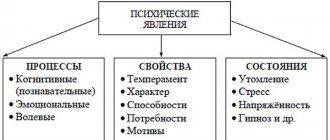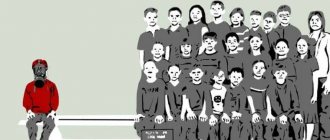In psychology, for a long time, insufficient attention was not paid to the study of the nature of emotional states, their types, properties and mechanisms of manifestation. The study of this neurophysiological phenomenon began in the 50-60s of the 20th century.
The first who paid due attention to the study of emotional states of the individual was the Soviet scientist N.D. Levitov, who attributed them to the manifestation of general mental states of a person. This gave impetus to the further development of psychological research devoted to the emotional sphere.
What is it: concept
Emotionality is the reaction of the psyche to various circumstances of life, which determines the direction of an individual’s actions. It is connected with the outside world through relationships of interdependence: what is happening around (the environment, the general atmosphere, people, events) directly affects the psycho-emotional state, which, in turn, can have an impact on the surrounding space.
There are some differences between emotions and feelings: the former are short-term, the latter are stable and longer lasting.
Management methods
There are 3 most reliable and proven techniques with which you can effectively control emotional states.
Psycho-emotional regulation
This method of controlling the emotional state involves activating memories of good or bad events that were experienced previously. For example, to suppress feelings of anger, irritation, rage, it is enough to think about a life situation in which there was an excessive amount of positive emotions, a feeling of happiness, joy.
Regulation of mental process
This method of managing emotional states is more complex, as it requires control over the thought process and consciousness.
The implementation of this method is carried out as follows:
- it is necessary to distract your thoughts from the negative events that occur in the environment;
- switch attention to other objects and objects that do not cause negative emotions;
- from each situation you should choose only that emotional component that does not cause stress;
- always adhere to the principle of a positive interpretation of any event;
- to attach insignificant significance to the current situation, as if it does not have any impact on life processes.
It is always recommended to redirect negative emotional impulses into various areas of life and professional activity.
Bodily regulation
This type of control over the emotional state involves performing distracting actions that do not allow you to focus on the feelings and emotional excitement that have arisen.
For example, counting beads located on hand rosaries. In this case, tactile contact of the fingers occurs, which creates a distraction effect. At the same moment, due to constant counting, attention dissipates.
An emotional state is a set of feelings, sensations, and emotional disturbances that are experienced over a long or short period of time. In psychology, scientists P.V. studied the psycho-emotional states of a person. Simonov, K.E. Izard, A.N. Leontyev.
Changes in emotional state occur under the influence of positive or negative environmental factors, and its forms of manifestation are closely related to all types of life processes. A person’s psycho-emotional states are filled with good and bad experiences, situations that influence his personal development and motivation to act.
Role and nature
Emotionality is a complex mental process consisting of three elements:
- Physiological. Reflects the changes that occur in the body when certain moods manifest themselves: breathing rate, heart muscle contractions, hormonal changes, metabolic processes).
- Psychological. Characterizes the experience itself: anger, joy, sadness.
- Behavioral. Manifests itself in facial expressions, gestures and actions (inhibited reaction, activity, aggression, crying).
The first two components represent the internal formation of the emotional state, while the third is responsible for its external manifestations. Often a person finds himself in a situation where he cannot openly express his feelings. There is a need for a deterrent or time delay. But one way or another, it is necessary to throw out the excess energy that arises inside. This can be done through physical activity or performing household activities (cleaning, switching to a hobby).
Emotions have a number of special characteristics:
- Polarity. They have a positive or negative connotation, although there may also be contradictions (you can love a person, but at the same time feel resentment, anger or anxiety towards him).
- Energy charged. There are sthenic experiences (causing increased activity - fury, irritation, inspiration, delight) and asthenic (causing passivity - sadness, fear).
- Integrity. Emotionality involves the interaction of all psychophysical aspects of the personality, which affect the entire body, manifesting itself in actions, in the body, and in the way of thinking.
- Inalienability. Emotions cannot be separated from other processes occurring in the psyche. They accompany everything - both the work of the senses (separating the pleasant from the unpleasant) and the functioning of the intellect (causing interest or boredom).
Development mechanism
In psychology, there are two groups of factors contributing to the development of psycho-emotional disorders: internal conditions and external influences. Internal conditions include features of the cognitive sphere: thoughts, ideas, fantasies. A negative assessment of events provokes negative emotions. Another group of internal factors are the psychophysiological characteristics of the body. The biological basis of emotions is the neurohumoral processes of the limbic and diencephalic systems of the brain, the exchange of serotonin, adrenaline, norepinephrine, and dopamine. An imbalance of these substances leads to the development of affective disorders.
Reactions to external environmental conditions can be innate and conditioned. Genetically embedded ways of responding - fear, aggression - are the basis for the formation of more complex emotional and behavioral patterns. During life, the development of affective disorders is facilitated by the processes of experiencing and consolidating traumatic experiences. Repetition or partial similarity of current events with past ones that caused negative experiences becomes the cause of psycho-emotional disorders.
Functions
- Subjective. The emotional state contributes to the formation of a certain point of view in the individual, and also allows one to establish connections with the outside world. Everything that happens is perceived by a person through the prism of his sensations.
- Communicative. With the help of such mental properties as empathy, we can determine the mood in which another individual is, which helps to establish contact or even manipulate others.
- Behavioral. Determining the vector of behavior, separating the pleasant from the unpleasant, the important from the unimportant.
Emotionality as a personality quality
It is easy to notice that people differ from each other both in the nature of the manifestation of emotions and in their quantity. There are those who are ready to squeal with delight or fall into hysterics for any reason. And others, in almost any situation, remain calm and even indifferent; perhaps they experience some experiences, but it can be difficult to notice them.
Manifestations of emotionality
Features of the emotional sphere of personality are manifested in a number of individual characteristics that leave an imprint on behavior as a whole.
- Level of excitability. This indicator is only partially related to the sphere of emotions and is more neurophysiological than mental in nature. But the nature of a person’s emotionality largely depends on it. More excitable people are, accordingly, more emotional. The level of excitability is associated with the speed and strength of nervous processes, primarily with the emergence of foci of excitation in the cerebral cortex.
- Emotional stability is determined by the duration of arousal, and therefore by the duration of experiencing certain emotions. Fleeting, superficial emotions, bright but unstable outbursts of feelings, frequent mood swings are signs of a fickle nature. But on the other hand, excessive fixation on certain experiences, “chewing” some emotional situation over and over again can lead to serious problems, including psychological ones.
- Strength and depth of experience. Strong emotions are characteristic of many bright, extraordinary personalities. Such emotional states play an important role in creativity; they support the energy, activity and performance of the individual on the path to success. On the other hand, such emotions themselves are energy-intensive; their experience often leads to emotional burnout - a feeling of devastation, apathy and mental fatigue.
- Expressiveness is the ability (and need) of a person to broadcast his emotions to others. Expressiveness is often mistaken for increased emotionality, but most often feelings are expressed more strongly than they are experienced, as people simply want to attract attention to themselves. Many people generally “play to the public” without experiencing even half of the emotions that a reserved, withdrawn, non-expressive person experiences.
The combination of these characteristics and their different levels makes each person a unique and unrepeatable personality from an emotional point of view. The nature and level of our emotions is associated with a number of reasons, among which two groups can be distinguished: individual characteristics of the nervous system and external factors.
Emotionality and temperament
One of the main reasons for differences in the emotional sphere of people is the characteristics of nervous processes, that is, temperament.
Without delving into the analysis of this concept, I will only say that the type of temperament is understood as the innate characteristics of the mental processes of excitation and inhibition in the cerebral cortex. The combination of characteristics such as strength, speed and the ratio of excitation and inhibition gives a huge variety of individual psychological types of people. They are conventionally divided into 4 main ones: choleric, phlegmatic, melancholic, sanguine. They do not occur in their pure form, but in most people the traits of one type predominate, and the rest are present in smaller quantities.
Each type is characterized by its own picture of emotionality, determined by the uniqueness of mental processes:
- Choleric. Due to the high speed and instability of mental processes, emotions in this type manifest themselves brightly, violently, but not for long. Cholerics are characterized by rapid changes in mood, but positive emotions predominate. After a little hysteria, the choleric quickly switches his attention to something pleasant. These people are amorous, but fickle, ready to support any project with enthusiasm and delight, but their enthusiasm does not last long.
- Phlegmatic person. The emotional opposite of choleric. This type of temperament is characterized by a high level of inhibition, so emotions in phlegmatic people arise with difficulty and do not manifest themselves clearly. The calmness of these people borders on coldness and callousness. However, the vaguely expressed feelings of phlegmatic people are very stable and often last a lifetime.
- Melancholic. This type is called weak due to the low level of activity of nervous processes. The change in mood of a melancholic person is almost imperceptible, but since negative emotions are objectively more stable than positive ones, people of this type are constantly in a state of despondency. They are easily upset and cannot create a positive mood on their own. On the other hand, this is a very sensitive type. Melancholic people are sensitive to changes in the mood of others, they have a high ability to empathize.
- Sanguine. This is a strong and stable type, he is capable of vivid emotions, which also last a long time. A sanguine person is better able to regulate his emotionality than any other type of temperament. But the persistence and even stubbornness of sanguine people, as well as their desire for dominance, sometimes makes these people aggressive and cruel.
Since we have traits of all four types to one degree or another, we can behave differently in different life situations. And emotionality itself, as a personal quality, is also formed and changed under the influence of external factors.
Classifications: all main types of emotions
Throughout life we experience a colossal amount of experiences. Not all of them can be described in two words; many are contradictory and ambiguous.
There are many different approaches to systematizing and classifying emotional states. The simplest of them is presented in the table below.
| Type | Description | Examples |
| Positive | They bring satisfaction, together they create a feeling of contentment with what is happening, happiness. | Sympathy, love, delight, inspiration. |
| Negative | They create general dissatisfaction and bad mood. | Fear, sadness, envy, grief, sadness, resentment, anger, melancholy. |
| Neutral | Do not directly influence the actions of the individual. | Indifference, surprise, interest. |
Dodonov classification
This diagram is more common in psychology and shows the distribution of types of experiences by function:
- Communicative (occurs in the process of communication).
- Altruistic (associated with the desire to benefit people).
- Praxic (appears when the plan is successfully completed).
- Gloric (need for self-affirmation).
- Pugnetic (attraction to risk, danger).
- Romantic (imply a desire for something new and unusual).
- Aesthetic (the appearance is determined by interaction with the sphere of art).
- Gnostic (formed with a desire for knowledge).
- Akizivnye (based on accumulation, gathering).
- Hedonic (aimed at experiencing pleasure).
Leontief classification
According to this approach, types of emotions are divided based on the source that generated them. Experiences can be caused by:
- the degree of satisfaction of certain needs;
- other people’s desires and the individual’s attitude towards them;
- relationships;
- contempt;
- drawing analogies between the real and the ideal (compliance of the individual with internal requirements, expectations, norms);
- comparison of one’s “I” with social standards.
However, this division option raises many questions because it is unclear. For example, what to do in the case when the same feeling can arise in building relationships and during self-analysis?
Psychologist Daria Milai
Make an appointment
Classification
An emotional state (in psychology this is reflected by the close connection between emotions, feelings and further actions of the person who experiences them) is a mental disturbance that arises under the influence of external and internal factors that are not constant.
After a change in the fundamental circumstances, this state of a person changes, which entails a change in the motivation for further actions. The table below describes the classification types of human emotional states.
| View | Characteristics of the psychophysiological process |
| Mood | Mood is a special type of emotional state that affects the thought process, the motivational part of behavior and actions manifested in a given situation. The occurrence of this psycho-emotional state is closely related to events in a person’s life, his health, the time of year, and his social circle. Most psychologists believe that mood is one of the weakest emotional states, which easily changes under the influence of environmental factors. This type of psycho-emotional state can be saturated with positive or negative emotions, feelings, the presence of which is an integral component of mood. |
| Affect | Affect is one of the most dynamically developing emotional states, which arises as a simultaneous explosion of emotions. This type of psycho-emotional state occurs suddenly, develops dynamically, but also changes very quickly. The main characteristic feature of affect is that in such a situation, a person’s consciousness loses control over actions and the decision-making process. This type of emotional state can be positive, or it can have negative consequences for the person under its influence. Affect becomes the cause of memory lapses, lack of recollection of a number of ongoing events. |
| Frustration | Frustration is a complex emotional state of a person that arises due to strong psychological and physical stress. The main irritant factor is one or another obstacle, due to the impact of which a person cannot achieve his goals and objectives. A growing emotional impulse in the form of dissatisfaction and strong indignation exceeds the limits of patience. The psycho-emotional state of frustration is characterized by the presence of pronounced irritation, anger, and disappointment in current events. Changing this emotional state is possible only if a person is able to overcome a conditional obstacle, finds other ways to achieve his goals, or redirects his attention to other environmental objects. |
| Passion | Passion is a strong, long-lasting and stable emotional state of a person, which causes maximum concentration of the thought process, and also redirects all the energy reserves of the body to achieve set goals. This type of psycho-emotional state can be short-term in nature, or accompany a person throughout his life. For example, a short burst of passion, which is realized during a declaration of love feelings for a loved one. The lasting type of this emotional state is characteristic of people who are obsessed with manic ideas, have addictions, and various types of mania. |
| Stress | Stress is a special emotional state of a person, which is a protective reaction of the body to the influence of aggressive environmental factors. There are several subtypes of this psycho-emotional state, in which every adult has found himself at least once. In the first case, stress may occur when ongoing events and emerging factors have a positive impact on the further development of the individual, facilitating its adaptation to radically new conditions and standards of life. Distress acts in exactly the opposite way, preventing further human activity, negatively affecting the functions of the nervous system, and provoking the development of serious diseases. Prolonged stay in this emotional state can lead to chronic feelings of anxiety, disturbances in the process of sleep and falling asleep, and the occurrence of long-term depression. |
Emotional state in psychology
Emotional state (in psychology this term is synonymous with the definitions “emotional process, phenomenon”) is a special way of manifesting feelings, which depends on the confluence of many factors. Therefore, it is possible that a person’s positive mood can change dramatically under the influence of a stressful situation, be accompanied by passion, or move to the stage of affect.
Forms and examples of emotional processes
- The emotions themselves. They can appear both in a collision with really existing situations, and when thinking about imaginary, non-existent events. They allow you to express satisfaction or dissatisfaction with what is happening, and give it an assessment based on the individual’s personal experience.
- Feelings. They are always stable (not momentary) and are distinguished by their brightness of expression. You can feel passion, love, resentment.
- Mood. The longest lasting mental state that affects the actions and well-being of the individual as a whole over a long period.
- Affects. An extreme form of expression that encourages short-term, uncontrollable changes in behavior. Completely irrational and very violent.
The relationship between the sensual and emotional sides
A more stable manifestation of emotionality is feelings. They, as a rule, arise on the basis of the needs of the second level (spiritual) and form a certain position, a person’s point of view. Classified according to the subject they are aimed at:
- Intelligent. Occur during mental activity (surprise, doubt, curiosity).
- Aesthetic. Their development is associated with the perception of beauty (love of art or some of its aspects, admiration for beauty).
- Moral. They characterize an individual’s attitude towards the behavior of other people. This assessment in most cases depends on the norms existing in society (humanity, altruism, friendship, compassion, pity, love).
There are also such concepts as state and reaction. They differ in the degree of duration and correlate the needs and aspirations of the individual with his capabilities and resources at the moment.
Emotions and their influence
Emotions are simple experiences caused by external or internal factors. They affect not only interaction with the outside world, but also health. If a person is depressed, depressed or constantly irritated, then he may develop certain diseases. The following largely depends on the ES:
- level of communication;
- speed of climbing the career ladder;
- development and realization of personal goals.
Emotions signal a favorable or unfavorable general state of physical and mental health. It is interesting that different people experience identical emotions in their own way. It all depends on the degree of their influence on certain things:
- Perception. A person who experiences joy sees the world through an optimistic lens. A pessimist, on the contrary, considers any remark a fatal reason for another upset.
- Cognitive process. Imagination, thinking and memory begin to work differently under the sphere of the next emotion. An angry person feels that everything around him is wrong, and he has a tendency to reject alien information. In a state of fear, people do not know how to think logically and make informed decisions. In an elevated mood, the ability to learn either increases many times over or is completely lost.
- Actions. Experience complexes affect activities: work, study, games. If, for example, disgust arises towards some component, then the person will begin to diligently avoid the activity as a whole. This happens in large work teams when hostility arises between employees, as a result of which someone quits.
- Consciousness. It is believed that emotions flow into one another and do not change abruptly. Some researchers view emotions as a separate conscious state. It is believed that they have no boundaries, and consciousness without emotions does not exist.
Izard's Differential Emotions
The scientist identified the following fundamental experiences:
- Interest. This feeling is directly related to a person’s sociality. Only with him is it possible to acquire new skills, knowledge, skills, and develop physically and mentally.
- Pleasure. It is a kind of synonym for joy. Creates a positive background, a good, cheerful mood. Appears when there is an opportunity to satisfy an important need for an individual. It can increase self-confidence, facilitate the process of establishing communication, and get rid of anxiety and stress.
- Astonishment. A short-term reaction to a collision of the psyche that has just occurred with a certain unexpected event, phenomenon or action.
- Anger. A negative state characterized by the impossibility of getting what you want, failure, or dissatisfaction with someone's behavior. The uncontrollable form is rage.
- Disgust. It arises due to interaction with an object that is unpleasant for the individual. Accompanied by a thirst to get rid of the provoking factor.
- Contempt. It manifests itself in the process of disagreement between people’s beliefs and actions.
- Shame. It is formed due to the inconsistency of certain aspects of the personality with one’s own requirements or public opinion. It is often accompanied by an unpleasant feeling of helplessness.
- Guilt. It arises as a result of condemnation of one’s own behavior. Brings with it repentance.
- Fear. Associated with the awareness of an emerging or imaginary threat to life.
- Grief. Reaction to negative events.
There is also a scale that allows you to determine the prevailing emotional state of an individual.
| Manifestations | Sum of points | Category | |||||
| Attentive | Concentrated | Assembled | C1 Interest | ||||
| Enjoying | Happy | Glad | C2 Pleasure | ||||
| Surprised | Amazed | Stricken | C3 Surprise | ||||
| Sad | Sad | Broken | S4 Grief | ||||
| Excited | Angry | Insane | C5 Anger | ||||
| Dislike | Disgust | Disgust | C6 Disgust | ||||
| Contemptuous | Neglecting | Haughty | S7 Contempt | ||||
| Frightened | Horrified | In panic | C8 Fear | ||||
| Shy | Timid | Shy | C9 Shame | ||||
| Sorry | Guilty | Repentant | C10 Wines | ||||
Face-to-face consultation
What are the features and advantages of face-to-face consultation?
Find out more
Skype consultation
What are the features and benefits of Skype consultations?
Find out more
To determine your emotional state, you need to evaluate your current state of health in each column:
1 – absolutely not suitable;
2 – more likely yes than no;
3 – consent;
4 – completely true.
Next, count the sum of points in the lines of the list and calculate the coefficient using the formula:
KS = (C1 + C2 + C3 + C9 + C10) / (C4 + C5 + C6 + C7 + C8)
If the obtained value is >1, then the result is assessed as positive; if <1, there is a negative mood, close to depression.
Functions of emotions
Emotional states bring us many moments of pleasure, but often seem unnecessary. We would like to get rid of negative experiences, not worry about loved ones, not experience feelings of anger or fear. But emotions, even the most unpleasant ones, perform very important functions in our lives.
- Controlling or regulating function. Emotions, like negative or positive experiences, control our behavior, form motives and are the strongest incentive. After all, any living creature strives for what brings pleasure and tries to avoid unpleasant sensations.
- Evaluation function. Emotions help us make sense of a complex world and bring order to our relationships. They evaluate everything that happens to us: both good and bad. This assessment allows us to divide people into friends and enemies, and events into pleasant and unpleasant.
- Protective and mobilizing function. Emotions warn us of danger, and they also turn on the defense mechanisms of our body and mobilize forces to solve the problem.
- Signal or expressive. Emotions play a huge role in communication, conveying information to other people about our state and attitude. Expressive movements that accompany emotions are an important part of nonverbal communication.
- Synthesizing function. Emotions are a kind of “cement mortar” that connects events, images, and phenomena in memory. It is emotions that create in memory single blocks-complexes of events connected by experiences.
But along with positive and undoubtedly important and necessary functions, emotional states can also play a disorganizing role, that is, interfere with a person’s normal actions. The feeling of fear can develop into panic, which prevents you from properly comprehending the situation and making the right decision. Anxiety prevents you from concentrating on activities, for example, solving a problem on a test. And love, too, sometimes makes one’s head so dizzy that a person can no longer think about anything and does not evaluate his actions sensibly.
However, there is a way out. A person may well learn to control emotions and subordinate them to the control of the mind.
Emotional reactions
- Lability is the variability of the manifestation of experiences. They always fluctuate over a fairly wide range (from light sentimentality to hysteria).
- Monotony is monotony, static or no sensory responses to what is happening.
- Responsiveness and empathy - the ability to quickly and flexibly respond to external influences, the ability to put oneself in the place of another, to empathize.
- Viscosity – focusing on a long-term feeling (for example, instead of reacting to the situation, a person returns to old grievances, failures).
- Coarsening is the inability to realize the appropriateness and admissibility of expressing emotions, loss of restraint and delicacy.
- Alexithymia is difficulty in identifying one’s feelings and their expression, the inability to distinguish experiences from physical sensations.
- Rigidity – immobility and limited range of response.
Sometimes a person’s behavior is demonstrative in nature, which is associated with his social functions. That is, people portray a certain involvement and emotionality in a situation that requires it. In this case, they speak of the existence of an emotional action, and not a reaction.
What are emotional states
In psychology, the concept of “emotions” is used both in a broad sense, as emotional states, and in a narrow sense, as one of the types of these states, along with feelings, moods, affects, etc. Emotional states are a special class of mental phenomena that reflect attitudes man to the world.
Emotions and needs
Interacting with the world around us and with other people, a person constantly encounters situations that evoke different attitudes in him: joy or indignation, sadness or hatred, surprise or sympathy. That is, a person reflects the world and stores information in memory not only in images and concepts, but also in the form of sensory experiences - emotions.
Emotions are closely related to human needs. Those life circumstances, situations or people that contribute to the satisfaction of needs cause us positive emotions, and those that interfere or hinder us cause negative emotions. It's so simple and complicated at the same time.
- Firstly, we are not always aware of our needs, but we always experience the emotions associated with them. Therefore, we often cannot even explain to ourselves why we don’t like this or that person, or why our mood suddenly deteriorated.
- Secondly, a person lives a complex and multifaceted life, and often his needs come into conflict not only with the needs of other people, but also with his own desires. Therefore, understanding this confusing and chaotic whirlpool of emotions can be extremely difficult even for an experienced psychologist. You probably know that you can love and hate the same person at the same time, or be afraid and look forward to some event at the same time.
You can deal with your experiences only by realizing and bringing your confused desires and needs into at least relative order. Experienced psychotherapists can help a person with this. After all, only by understanding and accepting your needs or consciously abandoning them can you reduce the severity of negative experiences.
Psychophysiology of emotional states
Emotions are the oldest type of mental states; animals have them and are associated with the satisfaction of natural, and in higher animals, social needs.
- The antiquity of this type of mental state is confirmed by the fact that they are born in the old, from an evolutionary point of view, subcortical part of the brain - in the limbic system. By the way, the name is very telling. Limbo is purgatory, a place between heaven and hell, and even deeper lurks animal instincts and hidden, often dark desires and needs. They sometimes break through from the subconscious level, awakening in us strange emotions that frighten even ourselves.
- But the expression of emotions is controlled and controlled by the “youngest” and most rational part of the brain – the neocortex (“new cortex”). And when the rational part of the brain turns off, for example, during severe alcohol intoxication or in a state of passion, then emotions go out of our control, and behavior begins to be controlled by instincts, not reason.
Any external influence causes a focus of excitation in the cerebral cortex. If the irritation is weak, then the focus quickly fades, but the stronger the impact, the larger and more stable this focus is. Penetrating into the subcortical zone, it activates the centers of emotions.
Emotions, in turn, cause various changes in the physiological systems of the body, because emotions are a signal about the nature of the impact of the stimulus. And if they are negative, then our body is rebuilt, preparing to repel danger or run away from it. Moreover, for our brain, it turns out, it doesn’t matter whether the enemy is real or imaginary - the signal to restructure the body’s functioning is still received, and we experience various, often unpleasant, sensations. Thus, the emergence of a feeling of fear is accompanied by the following processes:
- Adrenaline is released into the blood, which should increase the supply of oxygen to the muscles and activate the sympathetic nervous system;
- blood and nutritional resources are directed to support the muscular system; this reduces the supply to other body systems, so a person feels cold, chills, his face turns pale, and due to lack of blood supply, dizziness and even loss of consciousness may occur;
- in order to cope with the increased needs for blood supply, the heart begins to beat faster, breathing quickens to supply the blood with oxygen and, as a result, difficulties arise with speech;
- rational control over behavior decreases, since the functions of the cerebral cortex are somewhat suppressed, and the person literally becomes stupid and does not think rationally well.
Changes in the functioning of various body systems under the influence of emotions are reflexive in nature, so we cannot consciously control them, but we can control emotions, at least at the initial stage of their occurrence. Our brain is quite capable of “persuading” the body not to succumb to feelings of fear or anger. And in psychotherapy there are special techniques and trainings that allow a person to learn to manage their emotions even in the most critical situations.
Managing emotions is necessary not only to regulate behavior, but also to maintain physical health. The fact is that negative feelings (and they are experienced more strongly by a person than positive ones) have very unpleasant consequences. Their systematic experience can lead to the development of psychosomatic diseases, primarily of the cardiovascular and digestive systems. It is these systems that are most affected by adrenaline surges and other physiological changes. That is, the saying: “All diseases come from nerves” has a rational basis.
Cognitive content
According to this classification, feelings are divided into simple and complex. The first ones are fast and bright (anger, joy). They occur momentarily, immediately upon encountering a factor that motivates them (for example, when a guy invites a girl on a date, she rejoices). The second ones are longer and often contradictory (after receiving an invitation, she begins to analyze the situation and doubt).
Why are emotions needed?
Emotions help:
- act;
- survive;
- attack or avoid danger;
- decisions;
- understand others.
They help other people understand us.
From an evolutionary perspective, the brain structures that process cognitive information (such as the neocortex) are much younger than other brain regions. From this we can conclude that the influence of emotions on human behavior is much stronger compared to cognition or logic.
In addition, other people's emotional states influence our own through the information they convey. When we see someone's fearful expression, we tend to immediately look for danger around us. Likewise, people feel comfortable and secure by sensing happiness in others. Emotional states can easily influence people's behavior.
Response scale
This technique is a questionnaire of 25 statements that determines the degree of development of empathy in an individual.
The person taking the test needs to rate his/her agreement: always, often, rarely, never.
| № | Judgment | Answer | |||
| IN | H | R | N | ||
| 1 | I feel sad when I see someone feeling lonely in company. | ||||
| 2 | When those around you cannot restrain themselves and openly show their emotions, it is unpleasant. | ||||
| 3 | When a person gets excited next to me, I feel the same. | ||||
| 4 | I believe that tears of happiness are stupid. | ||||
| 5 | I also experience the troubles of my friends. | ||||
| 6 | Sometimes love songs make me sensitive. | ||||
| 7 | I would be very worried if I had to convey bad news to anyone. | ||||
| 8 | My condition is greatly influenced by my environment. | ||||
| 9 | I would like to have a job that involves communication. | ||||
| 10 | I love seeing people receive gifts. | ||||
| 11 | When I see/hear that a person is crying, I get upset myself. | ||||
| 12 | Listening to certain music makes me feel happy. | ||||
| 13 | When I read a work of fiction, I worry so much, as if all this is happening in reality. | ||||
| 14 | I get angry when I see a person being treated horribly. | ||||
| 15 | I can remain calm even when everyone around me is panicking. | ||||
| 16 | It makes me nervous when people shed tears. | ||||
| 17 | When I make a decision, no one else's opinion usually matters. | ||||
| 18 | I also get angry when people around me are worried about something. | ||||
| 19 | I get worried if I see people worrying about trifles. | ||||
| 20 | I get worried when I see animals suffering. | ||||
| 21 | It's stupid to worry about what happens in a book or movie. | ||||
| 22 | I feel sad when I see weak people. | ||||
| 23 | I get very emotional when watching a film. | ||||
| 24 | I can be indifferent to any disturbance going on around me. | ||||
| 25 | Children cry for no serious reason. | ||||
Ask a question
Results
| № | Number of points per answer | |||
| B – I agree (always) | H - often | R - rarely | N - never | |
| 1 | 4 | 3 | 2 | 1 |
| 2 | 1 | 2 | 3 | 4 |
| 3 | 4 | 3 | 2 | 1 |
| 4 | 1 | 2 | 3 | 4 |
| 5 | 4 | 3 | 2 | 1 |
| 6 | 4 | 3 | 2 | 1 |
| 7 | 4 | 3 | 2 | 1 |
| 8 | 4 | 3 | 2 | 1 |
| 9 | 4 | 3 | 2 | 1 |
| 10 | 4 | 3 | 2 | 1 |
| 11 | 4 | 3 | 2 | 1 |
| 12 | 4 | 3 | 2 | 1 |
| 13 | 4 | 3 | 2 | 1 |
| 14 | 4 | 3 | 2 | 1 |
| 15 | 1 | 2 | 3 | 4 |
| 16 | 1 | 2 | 3 | 4 |
| 17 | 1 | 2 | 3 | 4 |
| 18 | 4 | 3 | 2 | 1 |
| 19 | 4 | 3 | 2 | 1 |
| 20 | 4 | 3 | 2 | 1 |
| 21 | 1 | 2 | 3 | 4 |
| 22 | 4 | 3 | 2 | 1 |
| 23 | 4 | 3 | 2 | 1 |
| 24 | 1 | 2 | 3 | 4 |
| 25 | 1 | 2 | 3 | 4 |
| Sum | ||||
Now calculate the results:
- 11 points - extremely reduced level of empathy;
- 12-36 - low;
- 37-62 - normal;
- 63-81 - high;
- 82-90 - elevated.
Condition assessment
The intense pace of life, ambition, stress, and a large amount of daily information lead to a person experiencing emotional difficulties.
Abraham Hicks scale
The scientist created a scale that describes the range from the most negative to the most positive emotions. Psychologists use it in their practice, clearly explaining to patients that any changes in the emotional background should occur gradually. But that doesn't mean progress will necessarily be slow. The point is that you cannot skip a single step, because it is impossible to immediately emerge from sadness into absolute happiness. All feelings above must be lived and not suppressed. Only in this way can you achieve a balanced positive attitude.
Geometric models
There is another classification of emotions: Plutschek’s three-dimensional diagram-model, where at the top there are basic sensations that are most clearly expressed, and below them are derivatives. Using it you can study the relationship of one feeling with another.
At the top are 8 basic emotions, and Roman numerals indicate the intensity of the manifestation.
Factors of psychological states
The leading factor in a person’s psychological state is, first and foremost, the state of his health. The parameters are determined by taking into account the level of stressful environment on daily life activities.
In addition to health, such factors include satisfaction with personal life, interpersonal relationships, financial situation and other points that show the degree of satisfaction with the surrounding reality.
The combination of several negative factors or the long-term negative impact of one of them leads to a deterioration in the psychological state. In cases where such perception of what is happening lasts for a long period or is excessively exciting, it is recommended to contact a specialist.
During individual or group sessions of psychotherapy, psychotraining, psychologists and, if necessary, psychiatrists, form readiness to overcome the level of influence of unfavorable conditions, provide assistance in activating the necessary volitional qualities that allow one to overcome difficult periods and eliminate problems with minimal psychological disturbances of the condition. Formed:
- focus of control;
- adequate high self-esteem;
- psychological activity;
- dominance of positive emotions without agitation.
People with high nervous system strength endure the inevitable difficulties of life more easily than people with a weak will.
Types of psychological states
Currently, the following types of psychological states are distinguished:
- Defined by the source of formation as personal and situational.
- Separated into a separate type according to the level of severity as superficial and deep.
- They may differ in duration; in such a situation, short-term, long-term, and medium-duration are distinguished.
- Differing in degree of awareness as unconscious and conscious.
- Characterized by emotional characteristics as neutral, positive and negative.
- Sorted according to the degree of influence: depressing (asthenic), activating (sthenic), negative and positive.
- The manifestations are divided according to the level of psychological, physiological and psychophysiological.
If we simplify all these types as much as possible, then all psychological states are divided into three leading groups: positive, negative and specific.
- The list of positive ones includes love, kindness, interest in learning, happiness and other positive factors. They are characterized by an increased level of social activity, positive mood, and a high degree of performance.
- Negative ones include anger, envy, fear, anger and other manifestations of states that are completely opposed to positive types; accordingly, they lead to a decrease in the level of performance and a positive perception of life.
- The list of specific states includes wakefulness, sleep, a state of altered consciousness and similar states.
In most cases, a person is able to determine his condition independently and assess the cause of its occurrence. Violation of self-determination indicates the presence of psychological disorders. At the moment, psychological states are just beginning to be closely studied as a separate area. Many criteria have not yet been clearly identified.
Problems of psychological states
The problems of psychological states are just beginning to be studied closely. The occurrence of disorders is often associated with external symptoms. But they can become the basis for discomfort and a feeling of psychological distress.
The occurrence of mental health problems leads to a sharp decrease in the quality of life. Patients feel general dissatisfaction. Psychological problems can become the basis for the formation of psychosomatic diseases. At the level of general dissatisfaction with life, patients often experience asymptomatic headaches or pain in the gastrointestinal tract. Insomnia often occurs. Psychosomatic conditions can manifest themselves in the form of dizziness and fainting, and lead to eating disorders. The most common violation is a decrease in the level of performance and readiness for social adaptation in the team.
Emotional stress
This is a special type of condition. It is characterized by pronounced psycho-emotional experiences of various conflict situations, which carry a long-term restriction on the satisfaction of biological and social needs.
Emotional stress is mainly of social origin. Moreover, their manifestation becomes more frequent with the development of scientific and technological progress. People are affected by the accelerated pace of life, information overload, environmental problems and ever-increasing urbanization. It is worth keeping in mind that emotional stress negatively affects the body, causing various pathological changes in it.
Characteristics of psychological state
Used to assess the mental activity of a particular individual. It is usually considered over a certain period of time. Preference is given to a long duration of the study, taking at least several days.
The results of short-term analysis can be overly influenced by temporary factors. Including minor troubles, simply feeling unwell, and uncertainty about carrying out a new activity. Long-term observation makes it possible to assess an individual’s tendency to joy or sadness, apathy and activity. In this situation, it is easier to take into account the mandatory combination of a person’s individual characteristics and environmental factors that surround him. An accurate determination is only possible with an adequate comparison of these factors.
After a thorough analysis, the prevailing characteristics of the psychological state are determined. Changes that involve psychological, emotional and physical parameters are taken into account. A long period of observation allows us to determine the main characteristics characteristic of a particular individual. For example, the predominance of the tendency to dominate and the intensity of positive and negative emotions, sadness or joy.
Due to this, the psychotype of a particular character can be formed. This can be used when the presence or suspicion of the presence of certain psychological diseases in developing a course of therapy. Also, the psychotype can be taken into account when determining suitability for a particular professional activity, character compliance with the requirements for the position held. This is especially important for military personnel, teachers, doctors, and social service employees.
Well-being
The emotional states of a person are directly dependent on the nature of his mental activity. At the same time, there is also feedback. A person who is in good condition is able to intensify his cognitive and volitional activity.
However, the emotional states of a person depend not only on the type of activity he performs. They are proportional to how you feel. And here you can also see feedback. After all, even a patient who is in a very serious condition is able to feel absolutely healthy during an emotional upsurge.
Emotions
Their main difference from affect is that this phenomenon can be long-lasting. Moreover, emotions do not only arise as a reaction to current events. They also appear during memories.
Emotional experiences have different colors. It can be dissatisfaction and pleasure. There are situations when, on the one hand, there is a feeling of tension, and on the other, relief in resolving the issue. Another manifestation of emotional states is calmness and excitement. The first of them is associated with a decrease in activity. Excitement, as a rule, is violent in nature; it arises when performing any work or during preparation for it.
There is a classification of emotions that distributes them according to their impact on the activities that a person conducts. These are two categories including:
1. Stenic emotions. Their appearance has a beneficial effect on human activity. Stenic emotions give additional strength and energy. They also contribute to the emergence of the courage necessary to make statements or actions. This emotional state of a person motivates him to many accomplishments. Moreover, to fulfill his plans, he uses the internal reserves of the body.
2. Asthenic emotions. They are characterized by stiffness and passivity.











